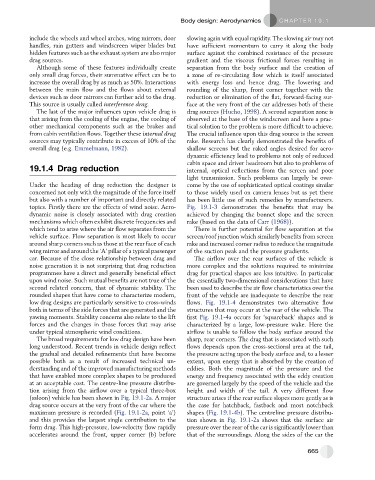Page 655 - Automotive Engineering Powertrain Chassis System and Vehicle Body
P. 655
Body design: Aerodynamics C HAPTER 19.1
include the wheels and wheel arches, wing mirrors, door slowing again with equal rapidity. The slowing air may not
handles, rain gutters and windscreen wiper blades but have sufficient momentum to carry it along the body
hidden features such as the exhaust system are also major surface against the combined resistance of the pressure
drag sources. gradient and the viscous frictional forces resulting in
Although some of these features individually create separation from the body surface and the creation of
only small drag forces, their summative effect can be to a zone of re-circulating flow which is itself associated
increase the overall drag by as much as 50%. Interactions with energy loss and hence drag. The lowering and
between the main flow and the flows about external rounding of the sharp, front corner together with the
devices such as door mirrors can further add to the drag. reduction or elimination of the flat, forward-facing sur-
This source is usually called interference drag. face at the very front of the car addresses both of these
The last of the major influences upon vehicle drag is drag sources (Hucho, 1998). A second separation zone is
that arising from the cooling of the engine, the cooling of observed at the base of the windscreen and here a prac-
other mechanical components such as the brakes and tical solution to the problem is more difficult to achieve.
from cabin ventilation flows. Together these internal drag The crucial influence upon this drag source is the screen
sources may typically contribute in excess of 10% of the rake. Research has clearly demonstrated the benefits of
overall drag (e.g. Emmelmann, 1982). shallow screens but the raked angles desired for aero-
dynamic efficiency lead to problems not only of reduced
cabin space and driver headroom but also to problems of
19.1.4 Drag reduction internal, optical reflections from the screen and poor
light transmission. Such problems can largely be over-
Under the heading of drag reduction the designer is come by the use of sophisticated optical coatings similar
concerned not only with the magnitude of the force itself to those widely used on camera lenses but as yet there
but also with a number of important and directly related has been little use of such remedies by manufacturers.
topics. Firstly there are the effects of wind noise. Aero- Fig. 19.1-3 demonstrates the benefits that may be
dynamic noise is closely associated with drag creation achieved by changing the bonnet slope and the screen
mechanisms which often exhibit discrete frequencies and rake (based on the data of Carr (1968)).
which tend to arise where the air flow separates from the There is further potential for flow separation at the
vehicle surface. Flow separation is most likely to occur screen/roof junction which similarly benefits from screen
around sharp corners such as those at the rear face of each rake and increased corner radius to reduce the magnitude
wing mirror and around the ‘A’ pillar of a typical passenger of the suction peak and the pressure gradients.
car. Because of the close relationship between drag and The airflow over the rear surfaces of the vehicle is
noise generation it is not surprising that drag reduction more complex and the solutions required to minimize
programmes have a direct and generally beneficial effect drag for practical shapes are less intuitive. In particular
upon wind noise. Such mutual benefits are not true of the the essentially two-dimensional considerations that have
second related concern, that of dynamic stability. The been used to describe the air flow characteristics over the
rounded shapes that have come to characterize modern, front of the vehicle are inadequate to describe the rear
low drag designs are particularly sensitive to cross-winds flows. Fig. 19.1-4 demonstrates two alternative flow
both in terms of the side forces that are generated and the structures that may occur at the rear of the vehicle. The
yawing moments. Stability concerns also relate to the lift first Fig. 19.1-4a occurs for ‘squareback’ shapes and is
forces and the changes in those forces that may arise characterized by a large, low-pressure wake. Here the
under typical atmospheric wind conditions. airflow is unable to follow the body surface around the
The broad requirements for low drag design have been sharp, rear corners. The drag that is associated with such
long understood. Recent trends in vehicle design reflect flows depends upon the cross-sectional area at the tail,
the gradual and detailed refinements that have become the pressure acting upon the body surface and, to a lesser
possible both as a result of increased technical un- extent, upon energy that is absorbed by the creation of
derstanding and of the improved manufacturing methods eddies. Both the magnitude of the pressure and the
that have enabled more complex shapes to be produced energy and frequency associated with the eddy creation
at an acceptable cost. The centre-line pressure distribu- are governed largely by the speed of the vehicle and the
tion arising from the airflow over a typical three-box height and width of the tail. A very different flow
(saloon) vehicle has been shown in Fig. 19.1-2a. A major structure arises if the rear surface slopes more gently as is
drag source occurs at the very front of the car where the the case for hatchback, fastback and most notchback
maximum pressure is recorded (Fig. 19.1-2a, point ‘a’) shapes (Fig. 19.1-4b). The centreline pressure distribu-
and this provides the largest single contribution to the tion shown in Fig. 19.1-2a shows that the surface air
form drag. This high-pressure, low-velocity flow rapidly pressure over the rear of the car is significantly lower than
accelerates around the front, upper corner (b) before that of the surroundings. Along the sides of the car the
665

